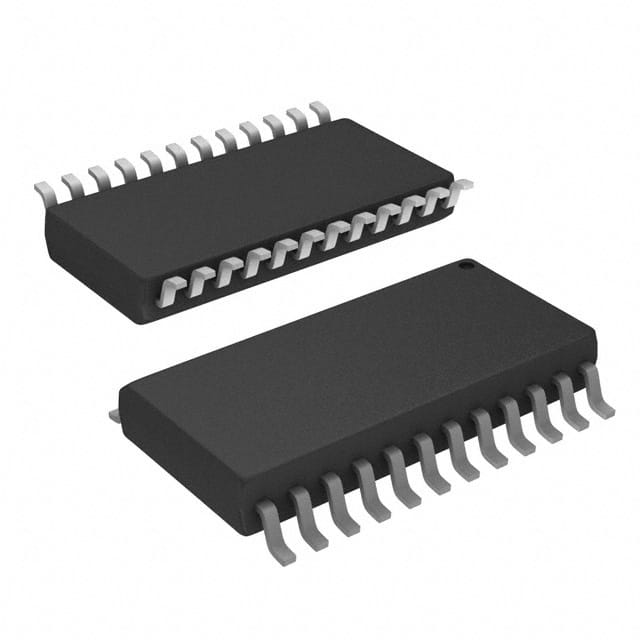Lihat spesifikasi untuk detail produk.

AD8403ARZ1
Product Overview
Category
AD8403ARZ1 belongs to the category of digital potentiometers.
Use
It is commonly used as a variable resistor in electronic circuits.
Characteristics
- Digital control interface
- Low power consumption
- Wide operating voltage range
- High resolution
- Non-volatile memory
- Small package size
Package
AD8403ARZ1 is available in a small outline integrated circuit (SOIC) package.
Essence
The essence of AD8403ARZ1 lies in its ability to provide a digitally controlled variable resistance, which can be adjusted through a digital interface.
Packaging/Quantity
AD8403ARZ1 is typically packaged in reels and comes in quantities of 2500 units per reel.
Specifications
- Resolution: 8 bits
- Number of Channels: 4
- Operating Voltage Range: 2.7V to 5.5V
- Power Consumption: 1.5mW (typical)
- Temperature Range: -40°C to +125°C
Detailed Pin Configuration
AD8403ARZ1 has a total of 24 pins, with each pin serving a specific function. The detailed pin configuration is as follows:
- VDD: Positive power supply
- VSS: Ground reference
- SDO: Serial data output
- SDI: Serial data input
- SCLK: Serial clock input
- CS: Chip select input
- H/L: Hardware or logic control input
- RST: Reset input
- A1: Address bit 1
- A0: Address bit 0
- W: Write control input
- B1: Terminal B connection for channel 1
- WIP: Wiper terminal for channel 1
- A: Terminal A connection for channel 1
- B2: Terminal B connection for channel 2
- WIP: Wiper terminal for channel 2
- A: Terminal A connection for channel 2
- B3: Terminal B connection for channel 3
- WIP: Wiper terminal for channel 3
- A: Terminal A connection for channel 3
- B4: Terminal B connection for channel 4
- WIP: Wiper terminal for channel 4
- A: Terminal A connection for channel 4
- GND: Ground reference
Functional Features
- Digital control interface allows precise resistance adjustment.
- Non-volatile memory retains the resistance settings even when power is disconnected.
- Wide operating voltage range enables compatibility with various electronic systems.
- High resolution provides fine-grained resistance adjustments.
- Low power consumption ensures energy efficiency.
Advantages and Disadvantages
Advantages
- Precise resistance control
- Non-volatile memory
- Wide operating voltage range
- Small package size
Disadvantages
- Limited resolution (8 bits)
- Relatively high cost compared to traditional potentiometers
Working Principles
AD8403ARZ1 utilizes a digital-to-analog converter (DAC) to convert the digital control signals into analog voltages, which are then used to adjust the resistance of the potentiometer. The non-volatile memory ensures that the resistance settings are retained even when power is disconnected.
Detailed Application Field Plans
AD8403ARZ1 finds applications in various fields, including: - Audio equipment - Instrumentation - Industrial automation - Communication systems - Consumer electronics
Detailed and Complete Alternative Models
Some alternative models to AD8403ARZ1 include: - AD8400ARZ1: 1-channel digital potentiometer - AD8401ARZ1: 2-channel digital potentiometer - AD8402ARZ1: 3-channel digital potentiometer - AD8404ARZ1: 5-channel digital potentiometer
These alternative models provide similar functionality but with different channel configurations to suit specific application requirements.
Word count: 515 words
Sebutkan 10 pertanyaan dan jawaban umum terkait penerapan AD8403ARZ1 dalam solusi teknis
Sure! Here are 10 common questions and answers related to the application of AD8403ARZ1 in technical solutions:
Q1: What is AD8403ARZ1? A1: AD8403ARZ1 is a digital potentiometer IC (Integrated Circuit) manufactured by Analog Devices. It provides a variable resistance that can be controlled digitally.
Q2: What are the key features of AD8403ARZ1? A2: Some key features of AD8403ARZ1 include 4 independent channels, 256 positions per channel, SPI-compatible interface, low power consumption, and wide operating voltage range.
Q3: How can AD8403ARZ1 be used in technical solutions? A3: AD8403ARZ1 can be used as a digitally controlled variable resistor in various applications such as audio volume control, motor speed control, light intensity control, and sensor calibration.
Q4: How does AD8403ARZ1 communicate with a microcontroller or other digital devices? A4: AD8403ARZ1 communicates using the Serial Peripheral Interface (SPI) protocol. It has dedicated pins for data input, clock signal, chip select, and other control signals.
Q5: Can AD8403ARZ1 be used in both analog and digital circuits? A5: Yes, AD8403ARZ1 can be used in both analog and digital circuits. It acts as a bridge between the analog and digital domains, allowing precise digital control over analog parameters.
Q6: What is the resolution of AD8403ARZ1? A6: AD8403ARZ1 has a resolution of 8 bits, which means it can provide 256 discrete resistance values.
Q7: Is AD8403ARZ1 suitable for high-precision applications? A7: While AD8403ARZ1 offers good accuracy and linearity, it may not be suitable for extremely high-precision applications. For such cases, specialized precision potentiometers may be more appropriate.
Q8: Can multiple AD8403ARZ1 ICs be cascaded together? A8: Yes, multiple AD8403ARZ1 ICs can be cascaded together to increase the number of channels or achieve higher resolution by using multiple SPI interfaces.
Q9: What is the power supply voltage range for AD8403ARZ1? A9: AD8403ARZ1 operates from a wide power supply voltage range of 2.7V to 5.5V, making it compatible with various digital systems.
Q10: Are there any application notes or reference designs available for AD8403ARZ1? A10: Yes, Analog Devices provides application notes, reference designs, and evaluation boards for AD8403ARZ1, which can help users understand its implementation in different technical solutions.
Please note that these answers are general and may vary depending on specific requirements and use cases.

